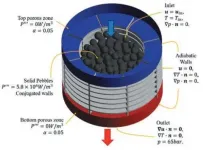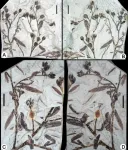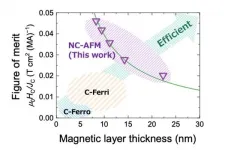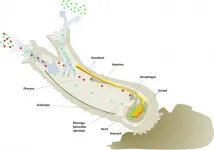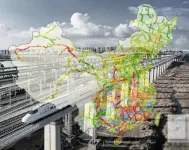(Press-News.org) When one of the largest modern earthquakes struck Japan on March 11, 2011, the nuclear reactors at Fukushima-Daiichi automatically shut down, as designed. The emergency systems, which would have helped maintain the necessary cooling of the core, were destroyed by the subsequent tsunami. Because the reactor could no longer cool itself, the core overheated, resulting in a severe nuclear meltdown, the likes of which haven't been seen since the Chernobyl disaster in 1986.
Since then, reactors have improved exponentially in terms of safety, sustainability and efficiency. Unlike the light-water reactors at Fukushima, which had liquid coolant and uranium fuel, the current generation of reactors has a variety of coolant options, including molten-salt mixtures, supercritical water and even gases like helium.
Dr. Jean Ragusa and Dr. Mauricio Eduardo Tano Retamales from the Department of Nuclear Engineering at Texas A&M University have been studying a new fourth-generation reactor, pebble-bed reactors. Pebble-bed reactors use spherical fuel elements (known as pebbles) and a fluid coolant (usually a gas).
"There are about 40,000 fuel pebbles in such a reactor," said Ragusa. "Think of the reactor as a really big bucket with 40,000 tennis balls inside."
During an accident, as the gas in the reactor core begins to heat up, the cold air from below begins to rise, a process known as natural convection cooling. Additionally, the fuel pebbles are made from pyrolytic carbon and tristructural-isotropic particles, making them resistant to temperatures as high as 3,000 degrees Fahrenheit. As a very-high-temperature reactor (VHTR), pebble-bed reactors can be cooled down by passive natural circulation, making it theoretically impossible for an accident like Fukushima to occur.
However, during normal operation, a high-speed flow cools the pebbles. This flow creates movement around and between the fuel pebbles, similar to the way a gust of wind changes the trajectory of a tennis ball. How do you account for the friction between the pebbles and the influence of that friction in the cooling process?
This is the question that Ragusa and Tano aimed to answer in their most recent publication in the journal Nuclear Technology titled "Coupled Computational Fluid Dynamics-Discrete Element Method Study of Bypass Flows in a Pebble-Bed Reactor."
"We solved for the location of these 'tennis balls' using the Discrete Element Method, where we account for the flow-induced motion and friction between all the tennis balls," said Tano. "The coupled model is then tested against thermal measurements in the SANA experiment."
The SANA experiment was conducted in the early 1990s and measured how the mechanisms in a reactor interchange when transmitting heat from the center of the cylinder to the outer part. This experiment allowed Tano and Ragusa to have a standard to which they could validate their models.
As a result, their teams developed a coupled Computational Fluid Dynamics-Discrete Element Methods model for studying the flow over a pebble bed. This model can now be applied to all high-temperature pebble-bed reactors and is the first computational model of its kind to do so. It's very-high-accuracy tools such as this that allow vendors to develop better reactors.
"The computational models we create help us more accurately assess different physical phenomena in the reactor," said Tano. "As a result, reactors can operate at a higher margin, theoretically producing more power while increasing the safety of the reactor. We do the same thing with our models for molten-salt reactors for the Department of Energy."
As artificial intelligence continues to advance, its applications to computational modeling and simulation grow. "We're in a very exciting time for the field," said Ragusa. "And we encourage any prospective students who are interested in computational modeling to reach out, because this field will hopefully be around for a long time."
INFORMATION:
"Abominable mystery" -- the early origin and evolution of angiosperms (flowering plants) was such described by Charles Robert Darwin. So far, we still have not completely solved the problem, and do not know how the earth evolved into such a colorful and blooming world.
Recently, a new angiosperm was reported based on numerous exceptionally well-preserved fossils from the Lower Cretaceous of Jiuquan Basin, West Gansu Province, Northwest China. The new discovery is the earliest and unique record of early angiosperms in Northwest China. The study has been accepted for publication in the journal National Science Review and is currently available online at https://doi.org/10.1093/nsr/nwab084.
The new angiosperm was named Gansufructus saligna, and all the fossil specimens ...
Atmospheric ozone, which can regulate the amount of incoming ultraviolet radiation on the Earth's surface, is important for the atmospheric environment and ecosystems. Tropospheric ozone, primarily originating from photochemical reactions, is the third most prominent greenhouse gas causing climate warming.
A research team led by Dr. Jinqiang Zhang from the Institute of Atmospheric Physics (IAP) of the Chinese Academy of Sciences tried to analyze vertical ozone distributions and explore the influence of deep stratospheric intrusions and wildfires on ozone variation in the northern Tibetan Plateau (TP) during the Asian summer monsoon period.
Their findings were published in Atmospheric Research.
Ozone variation over the TP can influence weather and climate change. ...
Researchers from the University of Surrey have revealed a new method that enables common laboratory scanning electron microscopes to see graphene growing over a microchip surface in real time.
This discovery, published in ACS Applied Nano Materials, could create a path to control the growth of graphene in production factories and lead to the reliable production of graphene layers.
Dispensing with the use of expensive bespoke systems, the new technique not only produces graphene sheets reliably but also allows to use fast-acting catalysts that reduce growth times from several hours to only a few minutes.
With the use of video imagining, the team from Surrey's Advanced Technology Institute (ATI) have shown graphene growing over an iron catalyst, using a silicon nitride ...
Sloughed off skin and bodily fluids are things most people would prefer to avoid.
But for marine biologist like Cheryl Lewis Ames, Associate Professor of Applied Marine Biology in the Graduate School of Agricultural Science at Tohoku University (Japan), such remnants of life have become a magical key to detecting the unseen.
Any organism living in the ocean will inevitably leave behind traces containing their DNA - environmental DNA (eDNA) - detectable in water samples collected from the ocean
Only recently has molecular sequencing technology become ...
Researchers at the University of Zurich show how climate mitigation scenarios can be improved by taking into account that the financial system can play both an enabling or a hampering role on the path to a sustainable economic system.
To limit global warming, a profound transformation of energy, production and consumption in our economies is required. The scale of the transformation means that the financial system must have a proactive role. New green investments are needed, as well as a reallocation of capital from high to low-carbon activities. The Central Banks and Supervisors Network for Greening the Financial ...
Researchers at Tohoku University and the Japan Atomic Energy Agency (JAEA) have discovered a new spintronic phenomenon - a persistent rotation of chiral-spin structure.
Their discovery was published in the journal Nature Materials on May 13, 2021.
Tohoku University and JAEA researchers studied the response of chiral-spin structure of a non-collinear antiferromagnet Mn3Sn thin film to electron spin injection and found that the chiral-spin structure shows persistent rotation at zero magnetic field. Moreover, their frequency can be tuned by the applied current.
"The electrical control of magnetic ...
It has previously been reported that human visual system has a temporal limitation in processing visual information when perceiving things that occur less than half a second apart. This temporal deficit is known as "attentional blink" and has been demonstrated in a large number of studies. These studies reported that adults could recognize two things when these two were temporally separated over 500 ms, but adults overlooked the second thing when the temporal interval was less than 500 ms. Recently, this attentional blink phenomenon has been observed in even preverbal infants less than one-year old.
In the study ...
Finnish researchers have been the first to determine the cause for the nonsyndromic early-onset hereditary canine hearing loss in Rottweilers. The gene defect was identified in a gene relevant to the sense of hearing. The study can also promote the understanding of mechanisms of hearing loss in human.
Hearing loss is the most common sensory impairment and a complex problem in humans, with varying causes, severity and age of onset. Deafness and hearing loss are fairly common also in dogs, but gene variants underlying the hereditary form of the disorder are so far poorly ...
If you've been to your local beach, you may have noticed the wind tossing around litter such as an empty potato chip bag or a plastic straw. These plastics often make their way into the ocean, affecting not only marine life and the environment but also threatening food safety and human health.
Eventually, many of these plastics break down into microscopic sizes, making it hard for scientists to quantify and measure them. Researchers call these incredibly small fragments "nanoplastics" and "microplastics" because they are not visible to the naked eye. Now, in a multiorganizational effort led by the National Institute of Standards and ...
Just half a degree Celsius less warming would save economic losses of Chinese railway infrastructure by approximately $0.63 billion per year, according to a new paper published by a collaborative research team based in Beijing Normal University and the Institute of Atmospheric Physics, Chinese Academy of Sciences, China.
The study, which appears in Transportation Research Part D recently, found that the rainfall-induced disaster risk of railway infrastructure has increased with increasing extreme rainfall days during the decades 1981-2016. Limiting global ...
